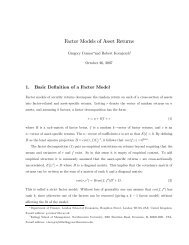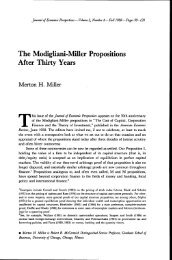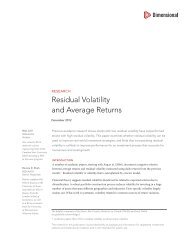Campbell, John Y, Jens Hilscher and Jan Szilagyi, 2005.
Campbell, John Y, Jens Hilscher and Jan Szilagyi, 2005.
Campbell, John Y, Jens Hilscher and Jan Szilagyi, 2005.
Create successful ePaper yourself
Turn your PDF publications into a flip-book with our unique Google optimized e-Paper software.
atios NITA <strong>and</strong> TLTA that use the book value of assets, with our ratios NIMTA <strong>and</strong>TLMTA that use the market value of assets. These measures are more sensitive tonew information about firm prospects since equity values are measured using monthlymarket data rather than quarterly accounting data.Second, we add lagged information about profitability <strong>and</strong> excess stock returns.One might expect that a long history of losses or a sustained decline in stock marketvalue would be a better predictor of bankruptcy than one large quarterly loss or asudden stock price decline in a single month. Exploratory regressions with laggedvalues confirm that lags of NIMTA <strong>and</strong> EXRET enter significantly, while lags of theother variables do not. As a reasonable summary, we impose geometrically decliningweights on these lags. We constructNIMT AAV G t−1,t−12 = 1 − φ31 − φ 12 ¡NIMTAt−1,t−3 + ... + φ 9 NIMTA t−9,t−12¢,(2)EXRETAV G t−1,t−12 = 1 − φ1 − φ 12 (EXRET t−1 + ... + φ 11 EXRET t−12 ), (3)where the coefficient φ = 2 − 1 3 , implying that the weight is halved each quarter.When lagged excess returns or profitability are missing, we replace them with theircross-sectional means in order to avoid losing observations. The data suggest thatthis parsimonious specification captures almost all the predictability obtainable fromlagged profitability <strong>and</strong> stock returns.Third, we add the ratio of cash <strong>and</strong> short-term investments to the market value oftotal assets, CASHMTA, in order to capture the liquidity position of the firm. A firmwith a high CASHMTA ratio has liquid assets available to make interest payments,<strong>and</strong> thus may be able to postpone bankruptcy with the possibility of avoiding italtogether if circumstances improve.Fourth, the market to book ratio, MB, captures the relative value placed on thefirm’s equity by stockholders <strong>and</strong> by accountants. Our profitability <strong>and</strong> leverage ratiosuse market value; if book value is also relevant, then MB may enter the regressionas a correction factor, increasing the probability of bankruptcy when market value isunusually high relative to book value. 66 Chacko, Hecht, <strong>and</strong> <strong>Hilscher</strong> (2004) discuss the measurement of credit risk when the market-tobookratio is influenced both by cash flow expectations <strong>and</strong> discount rates.11





